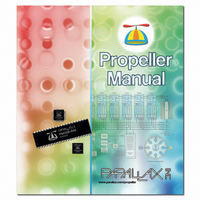122-32000 Parallax Inc, 122-32000 Datasheet - Page 230

122-32000
Manufacturer Part Number
122-32000
Description
MANUAL PROPELLER
Manufacturer
Parallax Inc
Specifications of 122-32000
Accessory Type
Manual
Lead Free Status / RoHS Status
Lead free / RoHS Compliant
For Use With/related Products
Propeller Education (PE) Kit
Lead Free Status / Rohs Status
Lead free / RoHS Compliant
- Current page: 230 of 438
- Download datasheet (5Mb)
LOCKNEW
– Spin Language Reference
LOCKNEW
Check out a new lock and get its ID.
((PUB ┆ PRI))
LOCKNEW
Returns: ID (0-7) of the lock checked out, or -1 if none were available.
Explanation
is one of four lock commands (
,
,
, and
) used to
LOCKNEW
LOCKNEW
LOCKRET
LOCKSET
LOCKCLR
manage resources that are user-defined and deemed mutually-exclusive.
checks out
LOCKNEW
a unique lock, from the hub, and retrieves the ID of that lock. If no locks were available,
returns -1.
LOCKNEW
About Locks
A lock is a semaphore mechanism that is used to communicate between to two or more
entities. In the Propeller chip, a lock is simply one of eight global bits in a protected register
within the Hub. The Hub maintains an inventory of which locks are in use and their current
states. Cogs can check out, set, clear, and return locks as needed during run time to indicate
whether a custom shared item, such as a block of memory, is available or not. Since locks
are managed by the Hub only one cog can affect them at a time, making this an effective
control mechanism.
In applications where two or more cogs are sharing the same memory, a tool such as a lock
may be required to prevent catastrophic collisions from occurring. The Hub prevents such
collisions from occurring on elemental data (such a byte, word or long) at every moment in
time, but it can not prevent “logical” collisions on blocks of multiple elements (such as a
block of bytes, words, longs or any combination of these). For example, if two or more cogs
are sharing a single byte of main memory, each one is guaranteed exclusive access to that
byte by nature of the Hub. But if those two cogs share multiple bytes of main memory, the
Hub can not prevent one cog from writing a few of those bytes while another cog is reading
all of them; all cogs’ interactions with those bytes may be interleaved in time. In this case,
the developer should design each process (in each cog that shares this memory) so that they
cooperatively share the memory block in a non-destructive way. Locks serve as flags that
notify each cog when a memory block is safe to manipulate or not.
Page 230 · Propeller Manual v1.0
Related parts for 122-32000
Image
Part Number
Description
Manufacturer
Datasheet
Request
R

Part Number:
Description:
MANUAL FOR SUMOBOT
Manufacturer:
Parallax Inc
Datasheet:

Part Number:
Description:
GUIDE STUDENT PROCESS CONTROL
Manufacturer:
Parallax Inc
Datasheet:

Part Number:
Description:
GUIDE STUDENT SMART SENSORS
Manufacturer:
Parallax Inc
Datasheet:

Part Number:
Description:
LEAD WIRES FLYING CABLE III/IV
Manufacturer:
Xilinx Inc
Datasheet:

Part Number:
Description:
BOARD ADAPTER AND FLY LEADS
Manufacturer:
Xilinx Inc
Datasheet:

Part Number:
Description:
PLATFORM CABLE USB II
Manufacturer:
Xilinx Inc
Datasheet:

Part Number:
Description:
KIT STARTER COOLRUNNER-II BUNDLE
Manufacturer:
Xilinx Inc
Datasheet:

Part Number:
Description:
Microcontroller Modules & Accessories DISCONTINUED BY PARALLAX
Manufacturer:
Parallax Inc

Part Number:
Description:
Microcontroller Modules & Accessories DISCONTINUED BY PARALLAX
Manufacturer:
Parallax Inc

Part Number:
Description:
BOOK UNDERSTANDING SIGNALS
Manufacturer:
Parallax Inc
Datasheet:

Part Number:
Description:
BOARD EXPERIMENT+LCD NX-1000
Manufacturer:
Parallax Inc
Datasheet:

Part Number:
Description:
IC MCU 2K FLASH 50MHZ SO-18
Manufacturer:
Parallax Inc
Datasheet:












